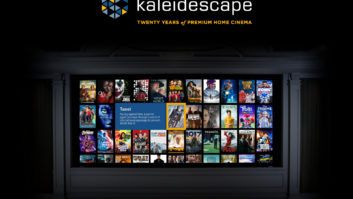On Friday and Saturday, word began circulating through message boards and media outlets that Kaleidescape had effectively closed down. The news signaled the demise of company that had invented the movie server category, dominated the high-end market with its unparalleled user interface, features, and performance, and pioneered a true Blu-ray-quality movie download store.
I’ve been covering Kaleidescape since it began in 2003, having been one of the first reviewers to evaluate the system writing, crediting its unrivaled role as a whole home entertainment machine. I had just spoken to company co-founder and current CEO, Cheena Srinivasan this past Monday where we discussed the company’s plans for this upcoming CEDIA. Srinivasan was excited about showing off some new technologies at the show, including new models of the Strato movie player and building excitement for the company’s Ultra HD downloads available at the Kaleidescape store where the company planned to have 27 UHD titles in HDR, including 4K UHD titles with Dolby Atmos.

KaleidescapeStrato
I reached out to Srinivasan again on Saturday afternoon and after confirming the bad news, it was clear that he was taking the decision incredibly hard. Throughout our half-hour call he repeatedly referred to the 70 Kaleidescape employees that had been laid off as family, and as a company that ran on passion. While Srinivasan accepted full responsibility for this outcome, ultimately it boiled down to a lack of funding, with the company perhaps taking on a bit too much in developing its latest product. Kaleidescape was a very engineering-heavy company that spent a lot of money on personnel and expensive new product development for its unique Internet Movie Store ecosystem to pivot the company from its disc-based past.
“We invested heavily into innovation and the finest re-creation of the movie experience in the home with internet-delivered content,” Srinivasan said. “We are also a device and movie service company like Amazon and Apple, and we knew that we had a differentiated solution by focusing on the experience, and pristine audio and video quality, which was only possible with download—true 4K, true HDR, never-buffered playback, pristine multichannel lossless audio, and a unique movie store. Everything had to be better for the premium, luxury market.”
The company’s latest product, the Strato, is an Ultra HD movie player that had all of the convenience of electronic delivery while retaining all of the quality of the disc. It took an incredible amount of time and resources to design and build from the ground up.
“Everything Kaleidescape builds is customized and beautifully integrated,” Cheena noted, “so that custom dealers can rest assured that the ‘it works’ promise from Kaleidescape is something they can count on and avoid truck rolls for servicing.”
In March 2014, Kaleidescape was dealt a blow in a court loss to the DVD-CCA, over a contract dispute case related to copying DVDs. Not only did this cost the company millions of dollars in legal fees and years of lost focus, it also meant the end of disc importing, the very feature the company was founded on. Resolving that lawsuit, however, allowed the company to move forward and establish studio relationships and unique licenses that ultimately led to “Kaleidescape 2.0” as the company pivoted to become the only premier digital media content delivery solution for home cinemas. While many think this lawsuit was the crux of Kaleidescape’s issues, it was never mentioned by Srinivasan in our conversation.
Rather one of the biggest contributors to the company’s current situation, according to Srinivasan, was a bad “bet” selecting a silicon supplier for 4K Ultra HD and HDR technology. “It is a major product transition, and we were on the leading edge of the technology curve as a small, under-capitalized company,” Srinivasan said. “And, because it was a whole new platform, it took much longer than expected to complete. And, we got caught with some bad, bad luck the last week of January this year.”
Srinivasan explained that Strato is Kaleidescape’s fourth generation player, and the company “bet heavily on” STMicro for the SoC (System-On-Chip.) In late January 2016, STMicro shuttered this business.” (The Bloomberg article can be read here.)
“Kaleidescape had huge dependency on this supplier to integrate various features to the Strato movie player, like Blu-ray playback support,” Srinivasan said. “Their business change led to a multiple-month and ongoing delay to finishing the product, which effectively wiped out our new product ramp up assumptions for this calendar year. Having never been through this before, I believed that with every passing month we would complete the Blu-ray support, and indeed real progress was made every month, but it was slow. Unfortunately, support for Blu-ray Disc on Strato Movie Player had a cascading effect; other software features such as HDR and Dolby Atmos were delayed due to the nature of software releases. A small company like us simply doesn’t have the financial wherewithal to handle so many risks. However, supply of these SoCs was never an issue at our volumes because very large companies are also using these chips.”
Srinivasan said the company has exhausted its financial resources, and attempts to raise capital didn’t materialize in a timely manner to extend the runway to deal with the transition and volume ramp up to new products.
With Kaleidescape’s headquarters located just outside the tech rich Silicon Valley, I asked Srinivasan if perhaps “venture capital” money was considered. He explained that Kaleidescape’s business model of luxury products (low volume compared to millions of consumers), and niche channel doesn’t fit into the typical mold of what the Valley VCs like to invest in. (Ironically, I wrote several years ago that Apple should purchase Kaleidescape with some of its free cash. Kaleidescape’s licensing agreements, security, and intellectual property could all mesh perfectly with Apple’s ecosystem.)
So, is Kaleidescape dead and gone?
“We expect someone will buy the assets within 30 days, and we are hoping whomever buys the assets will resume the support of our installed base, finish outstanding product development, and embark in a growth phase again,” Srinivasan said. “While there is no guarantee that we will find a buyer, the only reason for a buyer to emerge is if they have the confidence that there exists and will continue to be demand for a premium movie player and movie store for high-end home cinema installations. We should know within a few weeks’ time.”
When asked what the company’s closure would mean to existing customers and the continued viability of their systems, Srinivasan offered, “I am trying very hard to provide a mechanism to continue supporting and servicing systems. We need some time to figure all this out.”
Perhaps Kaleidescape’s single biggest “asset” is the good will that it has developed over the years. While some may criticize the company’s products for being overpriced, no one criticizes the system, interface, experience, service, support, or operation. Few products are as beloved by the industry or by owners as the Kaleidescape system, and to use a Kaleidescape is to rediscover and fall in love with your movie collection all over again.
If this is indeed the end of Kaleidescape, it is truly a sad day for both the industry and movie lovers everywhere. The passing of this truly great, visionary company would leave a technological hole in the industry that won’t soon be filled.





